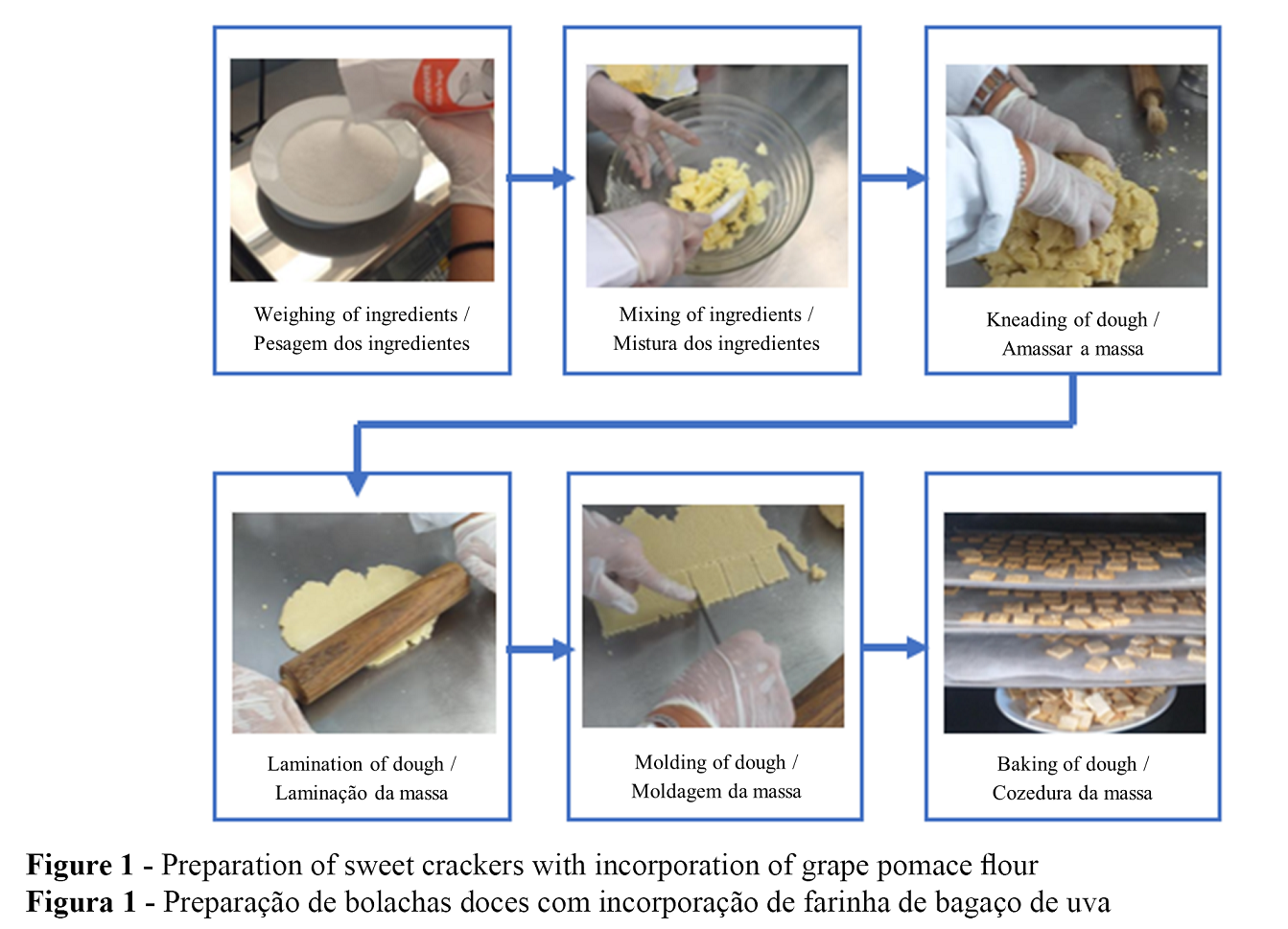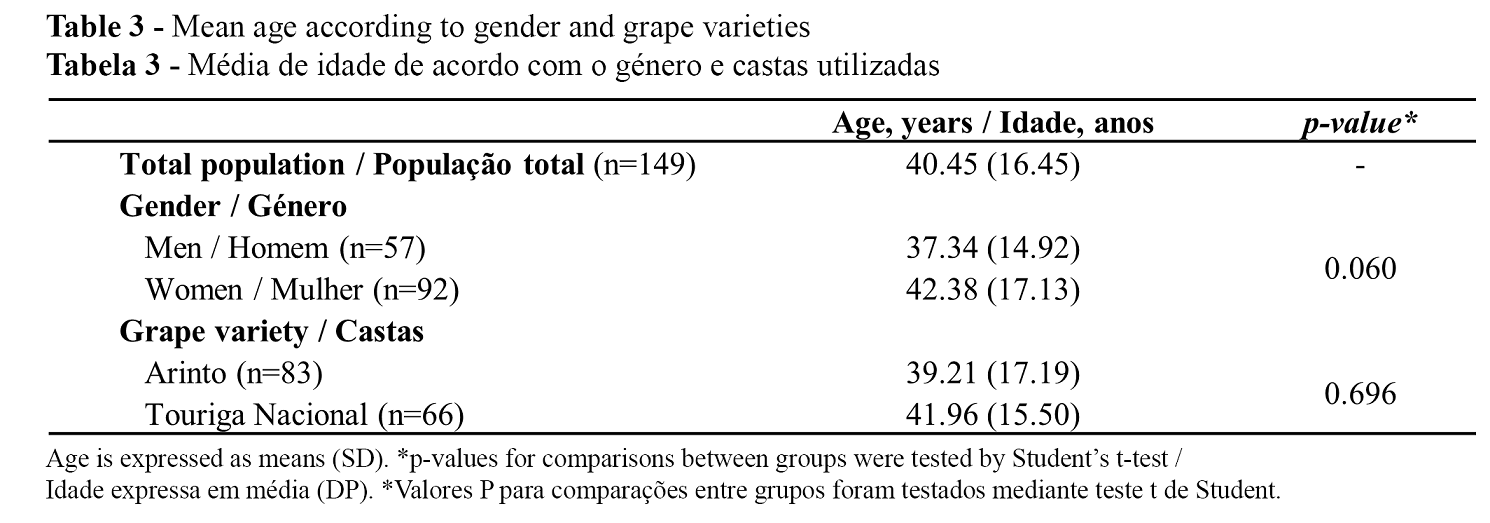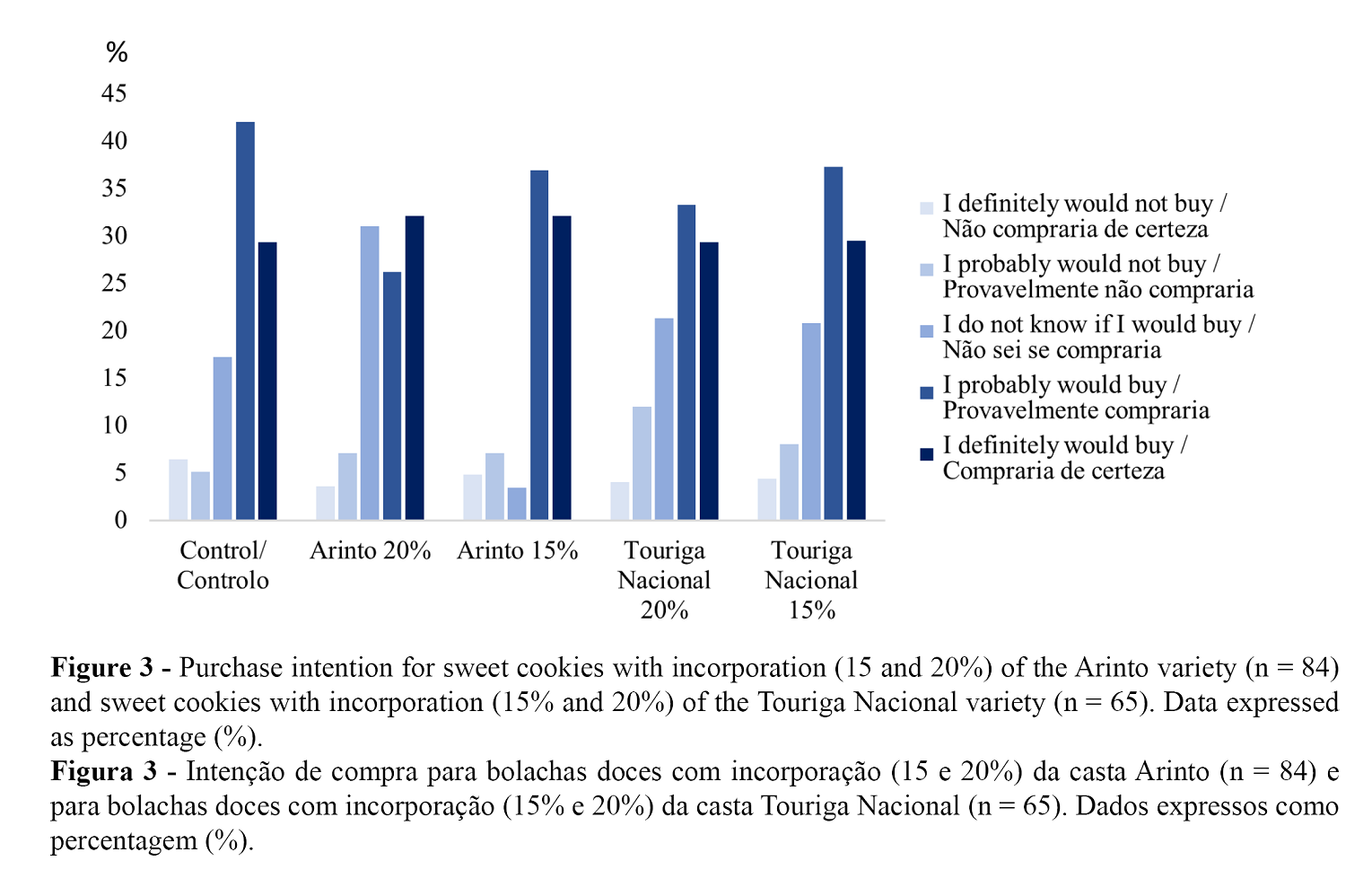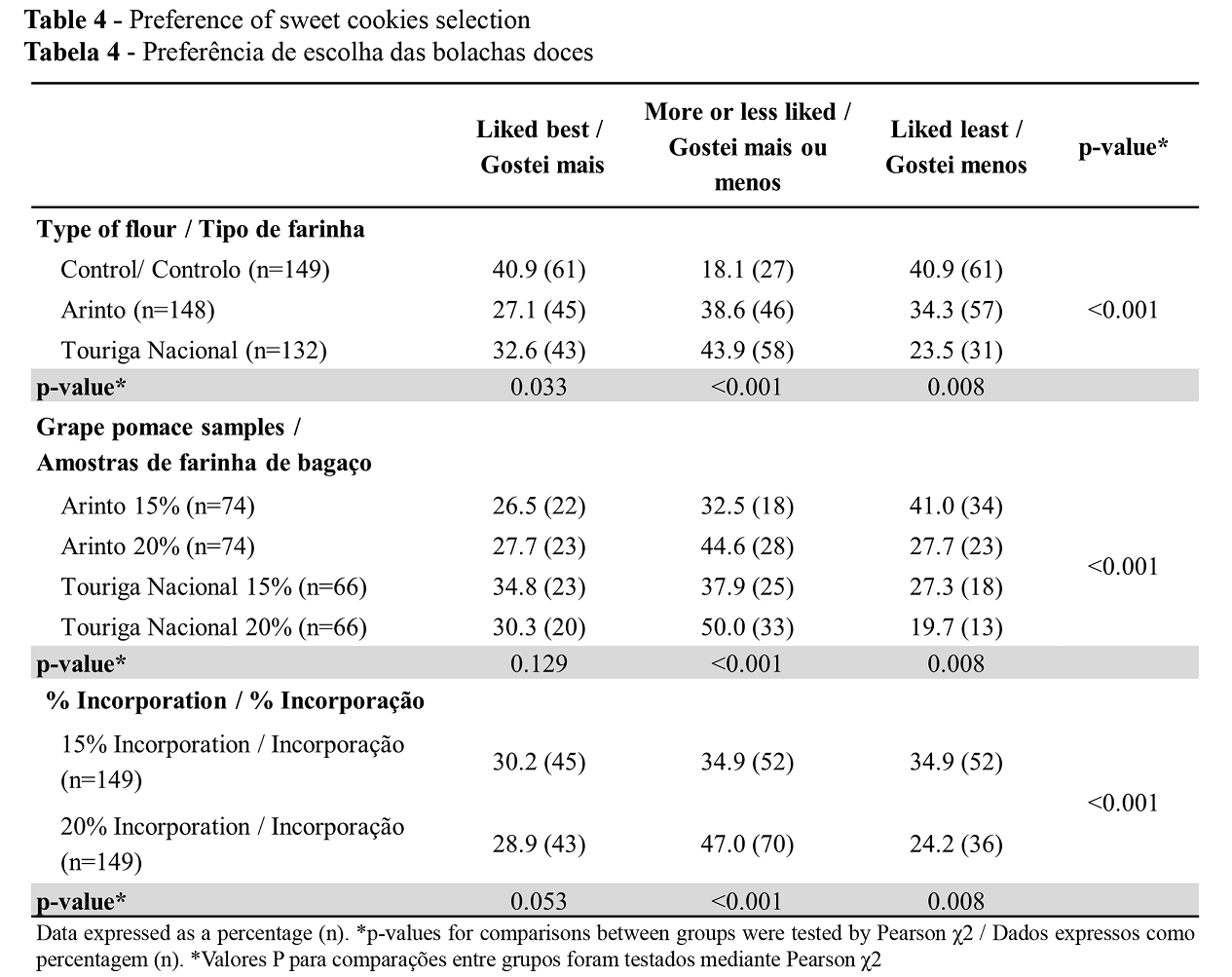![]()
Biopharmaceutical Sciences, Biomed Biopharm Res., 2021; 18(1):83-91
doi: 10.19277/bbr.18.1.249; download pdf version [+] here
Preliminary sensory evaluation of grape pomace flour sweet cookies
M. Lídia Palma 1*, Cíntia Ferreira-Pêgo 1, Marisa Nicolai 1, Paula Pereira1,2
1CBIOS – Universidade Lusófona's Research Center for Biosciences and Health Technologies, Av. Campo Grande 376, 1749-024 Lisbon, Portugal; 2CERENA - Instituto Superior Técnico (IST) Center for Natural Resources and Environment, Universidade de Lisboa, Av. Rovisco Pais, 1049-001 Lisboa, Portugal
*corresponding author:
Abstract
The sustainable use of resources and industrial waste is an important objective for environmental preservation and in the search for potential new foods and ingredients. Considering the size and importance of the wine industry, the use of winemaking waste in a sustainable manner is important for producers. Given the nutritional characteristics of this by-product, its use as an ingredient may be an interesting source of income, especially in Portugal, where around 183 thousand tons of this waste are generated annually. In addition to studies regarding the nutritional characteristics and active constituents, it is necessary to evaluate the acceptability of potential buyers to different food matrices resulting from the incorporation of grape pomace flour. This study was designed to evaluate the acceptability of sweet cookies with the incorporation of different percentages of grape pomace flour resulting from the vinification of Arinto and Touriga Nacional grape varieties. The sensory assessment of 149 individuals was evaluated using a questionnaire developed for this purpose. The results obtained are not conclusive, but there is a tendency for the preference for cookies with the incorporation of grape pomace flour at 15% versus incorporation of 20%, independent of the caste used.
Keywords: Grape pomace; sweet cookies; sensory evaluation; Touriga Nacional; Arinto
Received: 17/11/2020; Accepted: 06/02/2021
Introduction
The sustainable use of resources and the use of waste are currently important aspects of the political and social agenda of countries at a global level. In this sense, the 2030 agenda of the UN has defined 17 sustainable objectives, which aim to be a common vision of development for humanity, including sustainable production and development (1). The use of waste from the wine industry has been the target of several studies in recent years (2), since its use as fertilizer (3), as a source of antioxidants and polyphenols (4–6) or use in cosmetics (7) and the pharmaceutical industry (8), or as an additive in food (9). The most sustainable way of using pomace seems to be in the form of pomace flour for food purposes. In this way it can constitute not only an important product with food value (10,11) but also an important source of income for the main producing countries. Portugal is included among these countries, with a total planted area of 6.3% of the total national agricultural area (12) with annual wine production in 2019/202 of about 6.5 million hl (IVV) which generated about 183,000 tons of grape pomace (13). According to Regulation (EC) 1493/1999, pomace is the residue obtained after the pressing of fresh grapes, fermented or not, during the wine production process. Stalks, skins, and pips are integral parts of this residue. We have been studying (14) pomace flour, which results from the drying and milling of pomace. Studies regarding the importance and nutritional characterization of this product have indicated a constitution rich in polyphenols and antioxidants (14), low protein content, and high soluble and insoluble fiber content (15–18).
To introduce this flour as an ingredient in the food industry, it is necessary to complement the characterization studies of this product with consumer sensory evaluation studies using different matrices and different percentages of incorporation. In this sense, after the study of the sensory analysis of the incorporation of flour in a savory cracker (19), where a preference for cookies with higher percentages of incorporation was shown, the main objective of the present study was to preliminarily evaluate the acceptability of a sweet cookie with higher percentages of incorporation of pomace flour from one of two Portuguese grape varietals among a panel of untrained consumers.
Materials and Methods
Biological samples
The Carmin Cooperative winery in Reguengos de Monsaraz provided two types of grape pomace samples, one of white grape variety (Arinto) and another of red grape variety (Touriga Nacional). After receiving the samples, they were dried in an oven (J.P. Selecta, Barcelona, Spain), for 24 hours at 60 ºC, ground in a household slide crusher (Moulinex, Alencon, France), and finally stored in propylene bags properly sealed until their use.
Cookie preparation
Five sweet cookie recipes were prepared based on a recipe with wheat flour, which was replaced in percentages of 15% and 20% by grape pomace flour of the grape varieties (Touriga Nacional and Arinto). The ingredients used in the preparation of the sweet cookies were T55 extra-fine wheat flour (National), refined white sugar (Sidul), butter with salt (Agros), semi-skimmed milk (Agros), and grape pomace flour. The quantities of ingredients used are described in Table 1.
In the preparation of the dough, the sugar and butter were first added until a homogeneous and whitish mixture was obtained. Then the wheat flour and/or grape pomace flour and gradually the milk were mixed in to obtain a consistent dough. Finally, the dough was kneaded and allowed to rest for 10 minutes, then rolled thin and cut into small rectangles (3x2.5cm). The cookies were placed in an industrial oven (Eka KF912 - Tecnoeka Sri, Padova, Italy) for 10 minutes at 180 ºC, then remaining in the oven until it was completely cooled. The various stages of preparation of the cookies are shown in Figure 1.

Sensory evaluation
This study aimed at the preliminary analysis of sensory evaluation in a group of 149 untrained individuals of both sexes, aged between 18 and 88 years. Although the use of trained tasters panels is more commonly used in this type of evaluation, the use of untrained panels can be justified for the options of free choice, or non-validated questionnaires (20), as is the present case.
For the sensory test, taking into account the current pandemic context and the recommendations and norms of the General Directorate of Health (DGS), a questionnaire was created through the Google Forms platform, which the tasters accessed through a QR code on their smartphone or tablet and thus recorded their opinion at the time of the test. Participants were randomly recruited at the university campus on the tasting tests day.
Two tests were carried out on different days. The sensory test with integration of the Arinto caste grape pomace included 74 participants of both sexes aged between 16 and 88 (PD:17.27) years, and the test for the Touriga Nacional caste grape pomace included 66 participants of both sexes aged between 18 and 88 (PD: 15.88) years. The frequency scale used was developed by Palma and collaborators (19) in which the tasters gave their opinion regarding color, taste, texture, aroma, and overall final impression. The intention to purchase was also parameterized according to a 5 point scale according to that previously used by the same authors (19) and is described in Table 2. A comparative assessment of the samples was also made using a 3 point scale described in Table 4 and previously used by the authors (19).

Statistical analysis
Data were presented either as means and standard deviation (SD) for continuous variables or numbers and percentages for dichotomous variables. We compared the distribution of the selected characteristics between groups using Pearson χ2 tests for categorical variables or Student’s t-tests or analysis of variance (ANOVA), as appropriate, for continuous variables. All statistical tests were two-tailed and the significance level was set at P <0.05. All analyses were performed using the SPSS software version 26.0 (SPSS Inc, Chicago, IL, USA).
Results and Discussion
A total of 149 individuals (57 men and 92 women) with an average age of 40.45 (SD=16.45) participated in this work. The mean age according to sex and castes are summarized in Table 3. Individuals who tasted sweet cookies with the incorporation of Arinto bagasse flour had a mean age of 39.21 years, and those who tasted cookies with the incorporation of Touriga Nacional bagasse flour had a mean age of 41.96 years. No statistically significant differences were observed between the age and gender of the tasters who evaluated the two varieties. Figure 2 shows the results obtained from the sensory evaluation according to the different varieties and incorporations studied, in which it is possible to observe statistically significant differences regarding color, flavor, taste, and texture. Regarding color, the highest score obtained was for the control cookie, and the lowest scores were obtained for the two incorporations of Touriga Nacional. Similar results were obtained in the case of flavor since the control cookie obtained the highest score and the Touriga Nacional with 15% of incorporation had the lowest score. The two varieties with 20% incorporation were described as the least favorite flavor, with a score of 3.83 points over a maximum of 5. The cookie with 15% incorporation of grape pomace from the Touriga Nacional variety was the most accepted texture compared to the rest of the samples analyzed. Finally, the highest score concerning the overall appreciation was for the control of sweet cookies, and secondly for the incorporation of 15% of Arinto grape pomace. The lowest score was obtained for the incorporation of 20% Touriga Nacional. These differences were not statistically significant, however, the preference for cookies with the incorporation of Arinto flour is a factor previously observed in the sensory evaluation study of Palma et al (19).

The intention of purchasing sweet cookies with 15 and 20% of grape pomace incorporation of Arinto and Touriga Nacional grape varieties can be observed in Figure 3. The highest percentage of individuals who reported that they would certainly buy was relative to the sweet cookies with 15 and 20% of Arinto grape pomace incorporation (32.1% for each). The sweet cookies with the lowest purchase intention were the control sweet cookies since 6.4% of the total population reported that they had no intent to buy them

Finally, Table 4 shows the preferences of choice among all the samples analyzed. Regarding the analysis according to the type of flour, statistically, significant differences were observed between these cookies and the classification of “liked more,” “liked more or less,” and “liked less.” The most appreciated cookie was the control, followed by Touriga Nacional and finally, Arinto. These results are not in line with the opinion that the respondents expressed regarding individual parameters or overall appreciation. This apparent discrepancy is sometimes observed, as consumers can provide emotional type responses of “like” or “dislike” which do not always reflect the same pattern they express in the evaluation of various attributes on a hedonic scale of several points (20). Nevertheless, in this analysis of preference regarding the various incorporations and varieties, the most appreciated was Touriga Nacional with 15% grape pomace incorporation. However, these differences were not statistically significant. The highest percentage of individuals who appreciated less was relative to the sweet cookie with 15% incorporation of Arinto grape pomace. Finally, when the data were analyzed according to the incorporation percentage, the most appreciated sweet cookie was the one with 15% grape pomace incorporation, however, the differences were not statistically significant between the varieties. The highest percentage of individuals who did not appreciate the cookies analyzed also referred to the incorporation of 15% of grape pomace, thus, these results were inconclusive. It should be noted that the choice of 15% and 20% of grape pomace flour incorporation is related to the results obtained in a previous study conducted by Palma et al., in which the participants showed a clear preference for samples that contained the highest percentage of incorporation (15%). Also, previous studies with other matrices used percentages of incorporation of 20% (21-23), which is why we consider it important to evaluate the acceptability of the participants for higher incorporation than we had previously studied.

The main limitation of the study was the pandemic context and the recommendations and norms of the General Directorate of Health (DGS), which made it impossible to gather a group of trained tasters and used the methodology indicated for these types of tests. Other limitations were the form in which we accessed each participant’s opinion, as the questionnaire created through the Google Forms platform appeared not suitable for an overaged population. Another limitation was the exclusion and inclusion criteria; in the current context, the only criteria used were the availability and willingness to participate. The main strength was the possibility of assessing, for the first time, the acceptability of cookies with a 20% incorporation of grape flour. The maximum we had previously tested was 15% incorporation.
Conclusion
The results obtained although they show a preference for the control cookie, the differences are not statistically significant. It is not possible to conclude from these results which is the most appreciated incorporation by consumers. In the assessment with several attributes and the overall assessment, the respondents refer a preference for the cookie with 15% incorporation of flour from Arinto, without statistically significant differences. However, faced with the option of choosing between “liked a lot,” “liked more or less” and “did not like,” the cookie with the highest score, with statistically significant differences, is the cookie with 15% incorporation of flour from Touriga Nacional. The results showed a preference of consumers for the incorporation of 15% for both Arinto and Touriga Nacional flours, however, given the preliminary character of this study, we consider that other studies should be conducted with trained tasters in which increased incorporation of grape pomace flour is evaluated in both sweet and salty matrices.
Authors Contributions Statement
M.N, M.L.P, P.P - conceptualization and study design; M.N, M.L.P, P.P - experimental implementation; C.F.P. - data analysis; M.N, M.L.P, P.P, C.F.P. - drafting, editing and reviewing; C.F.P. - figures and graphics; M.N, M.L.P, P.P, C.F.P. - supervision and final writing.
Funding
This research was funded by Fundação para a Ciência e a Tecnologia (FCT, Portugal), through projects UIDP/04567/2020 and UIDB/04567/2020. P.P. Gratefully acknowledges the support of the CERENA strategic project FCT-UID/ECI/04028/2019.
C.F-P. is funded by Foundation for Fundação para a Ciência e a Tecnologia (FCT) Scientific Employment Stimulus contract with the reference number CEEC/CBIOS/NUT/2018.
Acknowledgments
The authors acknowledge all the participants.
Conflict of Interests
The authors declare that no financial or personal relationship could present a potential conflict of interest.
References
1 Organização das Nações Unidas (2015). Objetivos de desenvolvimento sustentável e o BCSD Portugal. Retrieved from https://unric.org/pt/objetivos-de-desenvolvimento-sustentavel/
- Gómez-Brandón, M., Lores, M., Insam, H., & Domínguez, J. (2019). Strategies for recycling and valorization of grape marc. Critical Reviews in Biotechnology, 39(4), 437–50. https://www.tandfonline.com/doi/abs/10.1080/07388551.2018.1555514
- Costa, M., Torres, A., Fernandes, A., Freitas, J., Teodósio, J., Pintado, M., & Leandro, E. (2007). a avaliação da qualidade do composto de bagaço de uva como fertilizante orgânico. Actas Portuguesas de Horticultura, 85–92.
- Fontana, A. R., Antoniolli, A., & Bottini, R. (2013). Grape pomace as a sustainable source of bioactive compounds: Extraction, characterization, and biotechnological applications of phenolics. Journal of agricultural and food chemistry, 61(38), 8987–9003.
- Oliveira, V.P.F. (2016). Valorização de subprodutos da vinha e do vinho - composição fenólica e atividade antioxidante[tese de Mestrado, Universidade Lusófona] de Humanidades e Tecnologias. http://hdl.handle.net/10437/7213
- Zacharof, M.P. (2017). Grape winery waste as feedstock for bioconversions: Applying the biorefinery concept. Waste Biomass Valor, 8, 1011–25. https://doi.org/10.1007/s12649-016-9674-2
- Soto, M.L., Falqué, E., & Domínguez, H. (2015). Relevance of natural phenolics from grape and derivative products in the formulation of cosmetics. Cosmetics, 2, 259-76. https://doi.org/10.3390/cosmetics2030259
- Leal, C., Gouvinhas, I., Santos, R.A., Rosa, E., Silva, A.M., Saavedra, M.J., & Barros, A.I.R.N.A. (2020). Potential application of grape (Vitis vinifera L.) stem extracts in the cosmetic and pharmaceutical industries: valorization of a by-product. Industrial Crops and Products,154:112675. https://doi.org/10.1016/j.indcrop.2020.112675
- García-Lomillo, J., & González-SanJosé, M. L. (2017). Applications of wine pomace in the food industry: Approaches and functions. Comprehensive reviews in food science and food safety, 16(1), 3–22. https://doi.org/10.1111/1541-4337.12238.
- Strapasson, G. C. (2016). Caracterização e utilização do resíduo de produção de vinho no desenvolvimento de alimentos com propriedade funcional. [tese de doutoramento, Universidade Federal do Paraná] Universidade Federal do Paraná. https://hdl.handle.net/1884/42386
- Yu, J. & Ahmedna, M. (2013). Functional components of grape pomace: Their composition, biological properties and potential applications. International Journal of Food Science and Technology, 48, 221–37. https://doi.org/10.1111/j.1365-2621.2012.03197.x
- Instituto Nacional de Estatística. (2021). Boletim Mensal da Agricultura e Pescas : janeiro de 2021.Retrieved March 5, 2021, from https://www.ine.pt/xurl/pub/71883762
- Hogervorst J. C., Miljić U., & Puškaš, V. (2017). Extraction of bioactive compounds from grape processing by-products. In Charis M. Galanakis (Eds.), Grape Processing By-Products(pp105-135). Handbook of Academic Press. ISBN 9780128098707 https://doi.org/10.1016/B978-0-12-809870-7.00005-3
- Nicolai, M., Pereira, P., Rijo, P., Amaral, O., Amaral, A.,& Palma, L. (2018). Vitis vinifera L. pomace: Chemical and nutritional characterization. Biomedical and Biopharmaceutical Research Journal, 15(2), 156–66. http://www.alies.pt/BBR%20Editions/Vol-15-2-2018/art2.pdf
- Antoniolli, A., Fontana, A. R., Piccoli, P., & Bottini, R. (2015). Characterization of polyphenols and evaluation of antioxidant capacity in grape pomace of the cv. Malbec. Food Chemistry, 178, 172–8. https://doi.org/10.1016/j.foodchem.2015.01.082
- Fontana, A., Antoniolli, A., D’Amario Fernández, M. A., & Bottini, R. (2017). Phenolics profiling of pomace extracts from different grape varieties cultivated in Argentina. RSC Advances, 7(47), 29446–57. https://doi.org/10.1039/C7RA04681B
- Abreu J, Quintino I, Pascoal G, Postingher B, Cadena R, & Teodoro A. (2019).Antioxidant capacity, phenolic compound content and sensory properties of cookies produced from organic grape peel (Vitis labrusca) flour. Int J Food Sci Technol., 54(4),1215–24. https://ifst.onlinelibrary.wiley.com/doi/abs/10.1111/ijfs.14100
- Mildner-Szkudlarz, S., Bajerska, J., Zawirska-Wojtasiak, R., & Górecka, D. (2013). White grape pomace as a source of dietary fibre and polyphenols and its effect on physical and nutraceutical characteristics of wheat biscuits. Journal of the Science of Food and Agriculture, 93(2), 389–95. https://doi.org/10.1002/jsfa.5774
- Palma, M.L., Nunes, M.C., Gameiro, R., Rodrigues, M., Gothe, S., Tavares, N., Pego, C., Nicolai, M., & Pereira, P. (2020) Preliminary sensory evaluation of salty crackers with grape pomace flour. Biomedical and Biopharmaceutical Research Journal, 17(1), 33–43. http://alies.pt/BBR%20Editions/Vol-17-1-2020/bbr.17.1.222.pdf
- Civille, G. V., & Oftedal, K. N. (2012). Sensory evaluation techniques - make “good for you” taste “good”. Physiology & Behavior, 107(4), 598–605. https://doi.org/10.1016/j.physbeh.2012.04.015
- Kuchtová, V., Kohajdová, Z., Karovičová, J., & Lauková, M. (2018). Physical, textural and sensory properties of cookies incorporated with grape skin and seed preparations. Polish Journal of Food and Nutrition Sciences,68(4), 309–17. https://doi.org/10.2478/pjfns-2018-0004
- Kuchtová, V., Karovičová, J., Kohajdová, Z., Minarovičová, L., & Kimličková, V. (2016). Effects of white grape preparation on sensory quality of cookies. Acta Chimica Slovaca, 9(2), 84–8. https://doi.org/10.1515/acs-2016-0014
- Civille, G.V., & Carr, B.T. (2015).Sensory evaluation techniques. (5th ed.). CRC Press, https://doi.org/10.1201/b19493
